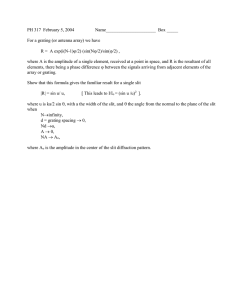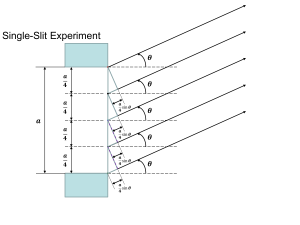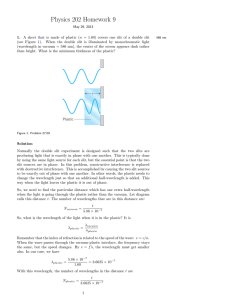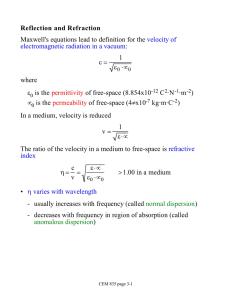d sin (θ) = m λ d = m λ sin (θ) = (2) (600 nm) sin (39.5 = 1.88656 × 10
advertisement
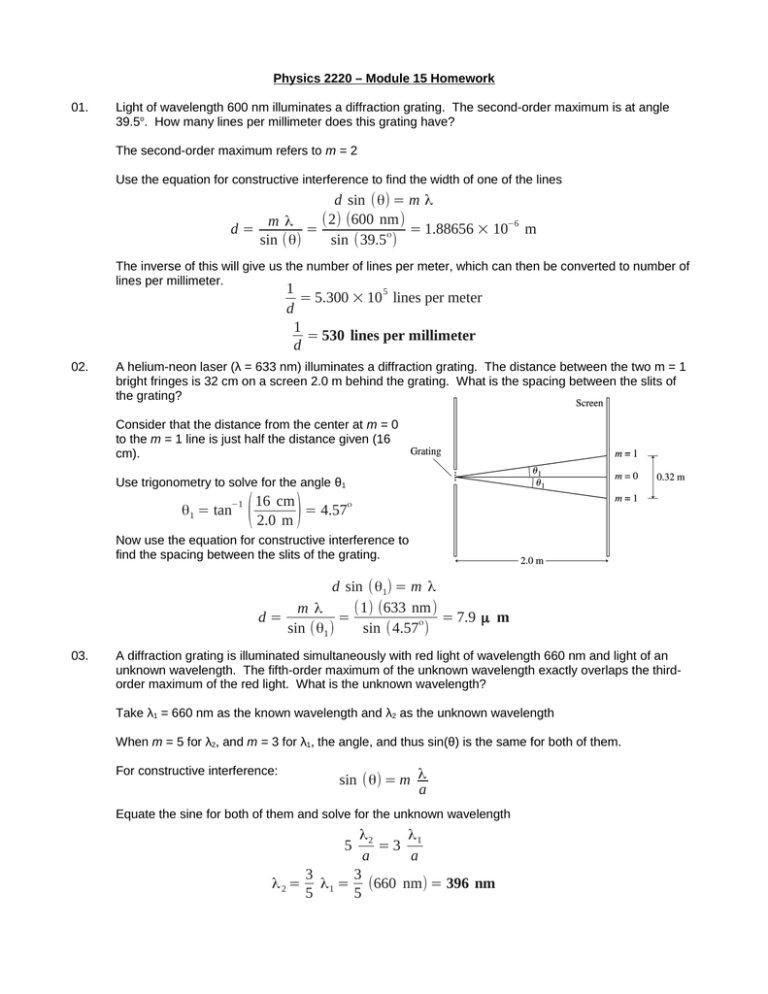
Physics 2220 – Module 15 Homework 01. Light of wavelength 600 nm illuminates a diffraction grating. The second-order maximum is at angle 39.5o. How many lines per millimeter does this grating have? The second-order maximum refers to m = 2 Use the equation for constructive interference to find the width of one of the lines d sin (θ) = m λ (2) (600 nm) mλ d= = = 1.88656 × 10−6 m sin (θ) sin (39.5ο) The inverse of this will give us the number of lines per meter, which can then be converted to number of lines per millimeter. 1 5 = 5.300 × 10 lines per meter d 1 = 530 lines per millimeter d 02. A helium-neon laser (λ = 633 nm) illuminates a diffraction grating. The distance between the two m = 1 bright fringes is 32 cm on a screen 2.0 m behind the grating. What is the spacing between the slits of the grating? Consider that the distance from the center at m = 0 to the m = 1 line is just half the distance given (16 cm). Use trigonometry to solve for the angle θ1 −1 θ1 = tan ( 162.0cmm ) = 4.57 ο Now use the equation for constructive interference to find the spacing between the slits of the grating. d sin (θ1) = m λ (1) (633 nm) mλ d= = = 7.9 μ m ο sin (θ1 ) sin (4.57 ) 03. A diffraction grating is illuminated simultaneously with red light of wavelength 660 nm and light of an unknown wavelength. The fifth-order maximum of the unknown wavelength exactly overlaps the thirdorder maximum of the red light. What is the unknown wavelength? Take λ1 = 660 nm as the known wavelength and λ2 as the unknown wavelength When m = 5 for λ2, and m = 3 for λ1, the angle, and thus sin(θ) is the same for both of them. For constructive interference: sin (θ) = m λ a Equate the sine for both of them and solve for the unknown wavelength λ2 λ =3 1 a a 3 3 λ 2 = λ 1 = (660 nm) = 396 nm 5 5 5 04. A helium-neon laser (λ = 633 nm) illuminates a single slit and is observed on a screen 1.5 m behind the slit. The distance between the first and second minima in the diffraction pattern is 4.75 mm. What is the width (in mm) of the slit? Recall the equation for destructive interference: sin (θm ) = m λ a The angle to the minima is missing. However we can take advantage of the small angle approximation to use known values to make a substitution: sin (θm ) ≈ tan (θm ) = Combined with the previous equation: ym L ym =m λ L a Now take the difference between two specific points as given in the problem: Δ y = y2 − y 1 = 2L λ Lλ − a a Determine the width of the slit: a= 05. (1.5 m ) (633 nm) Lλ = = 0.20 mm Δ y 4.75 mm Visible spectra of many stars, including the Sun, exhibit strong absorption lines of singly ionized calcium. Prominent among these are the H-line at 396.85 nm and the K-line at 393.37 nm. What resolving power is needed to distinguish them? Determine λ in the resolving power equation: λ= λ 1 + λ 2 393.37 nm + 396.85 nm = = 395.11 nm 2 2 Now find the resolving power: R= 395.11 nm λ = λ = = 114 λ2 − λ1 Δ λ 396.85 nm − 393.37 nm
